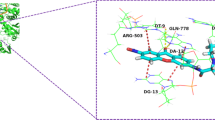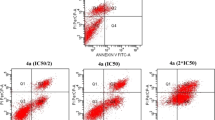Abstract
Three anthraquinones (1, 2 and 4), three stilbenes (5, 6 and 7) and 3,5-dihydroxybenzyl alcohol (3) were isolated from Reynoutria japonica. Their structures were identified as emodin (1), emodin-8-O-β-d-glucoside (2), 3,5-dihydroxybenzyl alcohol (3), citreorosein (4), cis-resveratrol (5), trans-resveratrol (6) and trans-resveratrol-5-O-β-d-glucopyranoside (7) by comparing their physicochemical and spectral data with published data. Compound 3 was isolated for the first time from the Polygonaceae family. Among the purified compounds, 3 showed more potent inhibitory activity against topoisomerase I (IC50: 4 μM) than camptothecin, as the positive control (IC50: 18 μM). Compounds 3, 4, 5, 6 and 7 showed stronger inhibitory activities toward DNA topoisomerase II (IC50: 0.54, 14, 15, 0.77 and 3 μM, respectively) than the positive control, etoposide (IC50: 44 μM). Compounds 1 and 4 displayed weak cytotoxicities against human lung cancer (A549), ovarian cancer (SK-OV-3), human liver hepatoblastoma (HepG2) and colon adenocarcinoma (HT-29) cell lines.
Similar content being viewed by others
References
Bachmann, M., Blaser, P., Luthy, J., and Schlatter, C., Toxicity and mutagenicity of anthraquinones from Aspergillus chevalieri. J. Environ. Pathol. Toxicol. Oncol., 11, 49–52 (1992)
Bae, G. H., The Medicinal Plants of Korea, Kyo-Hak Publishing Co., Ltd., Seoul, p.161, (2000).
Bosch, R., Friederich, U., Lutz, W. K., Brocker, E., and Bachmann, M., Investigations on DNA binding in rat liver and in Salmonella and on mutagenicity in the Ames test by emodin, a natural anthraquinone. Mutat. Res., 188, 161–168 (1987)
Bourrier, O. and Kakkar, A. K., Dendritic polymers containing a dimethylsilyl linked dihydroxybenzyl alcohol backbone: divergent synthesis, aggregation, functionalization, and an evaluation of their applications in catalysis. J. Mater. Chem., 13, 1306–1315 (2003).
Burns, J., Yokota, Y., Ashihara, H., Lean, M. E. J., and Crozier, A., Plant foods and herbal sources of resveratrol. J. Agric. Food Chem., 50, 3337–3340 (2002).
Chen, A. Y. and Liu, L. F., DNA topoisomerase: essential enzymes and lethal targets. Annu. Rev. Pharmacol. Toxicol., 34, 191–218 (1994).
D’Arpa, P. and Liu, L. F., Topoisomerase-targeting antitumor drugs. Biochim. Biophys. Acta, 989, 163–177 (1989).
Demirezer, L. Ö., Kuruüzüm-Uz, A., Bergere, I., Schiewe, H. J., and Zeeck, A., The structures of antioxidant and cytotoxic agents from natural source: anthraquinones and tannins from roots of Rumex patientia. Phytochemistry, 58, 1213–1217 (2001).
Fukuda, M., Nishio, K., Kanzawa, F., Ogasawara, H., Ishida, T., Arioka, H., Bojamowski, K., Oka, M., and Saijo, N., Synergism between cisplatin and topoisomerase I inhibitors, NB-506 and SN-38, in human small cell lung cancer cells. Cancer Res., 56, 789–793 (1996).
Fulvio, M., Fabiano, R., and Siegfried, K., Isolation, characterization, and evolution in red wine vinification of resveratrol monomers. J. Agric. Food Chem., 43, 1820–1823 (1995).
Gamini, S. J., Hiranthi, J., Lee, E. S., Koonchanok, N. M., Robert, L. G, Curtis, L. A., Jerry L. M., and Chang, C. J., Kinase inhibitors from Polygonum cuspidatum. J. Nat. Prod., 56, 1805–1810 (1993).
Hanawa, F., Tahara, S., and Nizutani, J., Antifungal stress compounds from Veratrum grandiflorum leaves treated with cupric chloride. Phytochemistry, 31, 3005–3007 (1992).
Hwang, H. Q., Li, H. L., Tang, J., Lv, W. P., and Zhang, W. D., A new aurone and other phenolic constituents from Veratrum schindleri Loes. F. Biochem. Syst. Ecol., 36, 590–592 (2008).
Jang, M., Cai, L., Udeani, G. O., Slowing, K. V., and Thomas, C. F., Cancer chemopreventive activity of resveratrol, a natural product derived from grapes. Science, 275, 218–220 (1997)
Jayasuriya, H., Koonchanok, N. M., Geahlen, R. L., McLaughlin, J. L., and Chang, C. J., Emodin, a protein tyrosine kinase inhibitor from Polygonum cuspidatum. J. Nat. Prod., 55, 696–698 (1992)
Jayatilake, G. S., Jayasuriya, H., Lee, E. S., Koonchanok, N. M., and Geahlen, R. L., Kinase inhibitors from Polygonum cuspidatum. J. Nat. Prod., 56, 1805–1810 (1993)
Lee, C. H., Kim, S. L., Lee, K. B., Yoo, Y. C., Ryu, S. Y., and Son, K. S., Neuraminidase inhibitors from Reynoutria elliptica. Arch. Pharm. Res., 26, 367–374 (2003).
Lee, Y. N., Flora of Korea. Kyo-Hak Publishing Co., Ltd., Seoul, p.114, (1996).
Lin, S. Y., Lai, W. W., Ho, C. C., Yu, F. S., and Chen, G. W., Emodin induces apoptosis of human tongue squamous cancer SCC-4 cells through reactive oxygen species and mitochondria-dependent pathways. Anticancer Res., 29, 327–335 (2009)
Liu, L. F., DNA topoisomerase poisons as antitumor drugs. Annu. Rev. Biochem., 58, 351–375 (1989).
Ma, W. L., Yan, C. Y., Zhu, J. H., Duan, G. Y., and Yu, R. M., Biotransformation of paeonol and emodin by transgenic crown galls of Panax quinquefolium. Appl. Biochem. Biotechnol., 160, 1301–19308 (2010).
Marquis, J. F., Markhey, D., LaVole, E. J., and Olivier, M., Effects of topoisomerases inhibitors protoberberine on Leishmania donovani growth, macrophage function and infection. J. Parasitol., 89, 1040–1052 (2003).
Matsuda, H., Shimoda, H., Morikawa, T., and Yoshikawa, M., Phytoestrogens from the roots of Polygonum cuspidatum (Polygonaceae): structure-requirement of hydroxyanthraquinones for estrogenic activity. Bioorg. Med. Chem. Lett., 11, 1839–1842 (2001)
Mattivi, F., Reniero, F., and Korhammer, S., Isolation, characterization, and evolution in red wine vinification of resveratrol monomers. J. Agric. Food Chem., 43, 1820–1823 (1995).
Mittra, B., Saha, A., Chowdhury, A. R., Pal, C., Mandal, S., Mukhopadhyay, S., Bandyopadhyay, S., and Majumder, H. K., Luteolin, an abundant dietary component is a potent anti-leishmanial agent that acts by inducing topoisomerase II-mediated kinetoplast DNA cleavage leading to apoptosis. Mol. Med., 6, 527–541 (2000).
Mueller, S. O. and Stopper, H., Characterization of the genotoxicity of anthraquinones in mammalian cells. Biochim. Biophys. Acta, 1428, 406–414 (1999)
Na, M. G., Jin, W. Y., Min, B. S., Ahn, J, S., and Bae, K. H., Protein tyrosine phosphatase 1B inhibitory activity of anthraquinones and stilbenes. Nat. Prod. Sci., 14, 143–146 (2008).
Nitiss, J. L., Targeting DNA topoisomerase II in cancer chemotherapy. Nat. Rev. Cancer, 9, 338–350 (2009).
Pommier, Y., DNA topoisomerase I and II in cancer chemotherapy: update and perspectives. Cancer Chemother. Pharmacol., 32, 103–108 (1993).
Pommier, Y., Topoisomerase I inhibitors: camptothecins and beyond. Nat. Rev. Cancer, 6, 789–802 (2006).
Potmesil, M., Camptothecins: from bench research to hospital wards. Cancer Res., 54, 1431–1439 (1994).
Ray, S., Hazra, B., Mittra, B., Das, A., and Majumder, H. K., Diospyrin, a bisnapthoquinone: a novel inhibitor of type I DNA topoisomerase of Leishmania donovani. Mol. Pharmacol., 54, 994–999 (1998).
Ren, H., Gu, Q., and Zhu, W., Secalonic acid D; A cytotoxic constituent from marine lichen-derived fungus Gliocladium sp. T3. Arch. Pharm. Res., 29, 59–63 (2006).
Rubinstein, L. V., Shoemaker, R. H., Paul, K. D., Simon, R. M., Tosini, S., Skehan, P., Scudiero, D. A., Monks, A., and Boyd, M. R., Comparison of in vitro anticancer-drug-screening data generated with a lines. J. Nat. Cancer Inst., 82, 1113–1118 (1990).
Shen, M. Y., Liu Y. J., Don, M. J., Liu, H. Y., and Chen, Z. W., Combined phytochemistry and chemotaxis assays for identification and mechanistic analysis of antiinflammatory phytochemicals in Fallopia japonica. J. Agric. Food Chem., 48, 253–256 (2011)
Slichenmyer, W. J., Rowinsky, E. K., Donehower, R. C., and Kaufmann, S. H., The current status of camptothecin analogues as antitumor agents. J. Natl. Cancer Inst., 85, 271–291 (1993).
Vastano, B. C., Chen, Y., Zhu, N., Ho, C. T., Zhou, Z., and Rosen, R. T., Isolation and identification of stilbenes in two varieties of Polygonum cuspidatum. J. Agric. Food Chem., 48, 253–256 (2000)
Walker, J. V. and Nitiss, J. L., DNA topoisomerase II as a target for cancer chemotherapy. Cancer Invest., 20, 570–589 (2002).
Wang, J. C., DNA topoisomerases. Annu. Rev. Biochem., 65, 635–692 (1996).
Xiao, K., Xuan, L., Xu, Y., Bai, D., and Zhong, D., Constituents from Polygonum cuspidatum. Chem. Pharm. Bull., 50, 605–608 (2002)
Xu, M. L., Zheng, M. S., Lee, Y. K., Moon, D. C., Lee, C. S., Woo, M. H., Jeong, B. S., Lee, E. S., Jahng, Y., Chang, H. W., Lee, S. H., and Son, J. K., A New stilbene glucoside from the roots of Polygonum multiflorum Thunb. Arch. Pharm. Res., 29, 946–951 (2006)
Yamada, M., Hayashi, K. I., Ikeda, S., Tsutsui, K., Tsutsui, K., Ito, T., Iinuma, M., and Nozaki, H., Inhibitory activity of plant stilbene oligomers against DNA topoisomerase II. Biol. Pharm. Bull., 29, 1504–1507 (2006)
Yu, B. C., Yang, M. C., Lee, K. H., Kim, K. H., Choi, S. U., and Lee, K. R., Two new phenolic constituents of Humulus japonicus and their cytotoxicity test in vitro. Arch. Pharm. Res., 30, 1471–1475 (2007).
Zhang, C., Wang, X., Zhang, X., Zhang, Y., and Xiao, H., Bioassay-guided separation of citreorosein and other oestrogenic compounds from Polygonum cuspidatum. Phytother. Res., 23, 740–741 (2009)
Zhang, L., Lau, Y. K., Xi, L., Hong, R. L., and Kim, D. S., Tyrosine kinase inhibitors, emodin and its derivative repress HER-2/neu-induced cellular transformation and metastasis-associated properties. Oncogene, 16, 2855–2863 (1998)
Author information
Authors and Affiliations
Corresponding author
Additional information
Thess authors contributed equally to this work.
Rights and permissions
About this article
Cite this article
Hwangbo, K., Zheng, M.S., Kim, YJ. et al. Inhibition of DNA topoisomerases I and II of compounds from Reynoutria japonica . Arch. Pharm. Res. 35, 1583–1589 (2012). https://doi.org/10.1007/s12272-012-0909-x
Received:
Revised:
Accepted:
Published:
Issue Date:
DOI: https://doi.org/10.1007/s12272-012-0909-x




